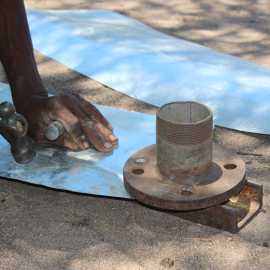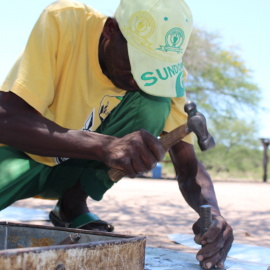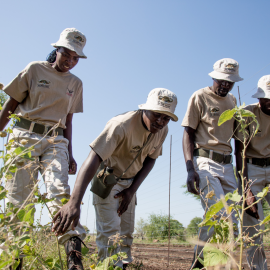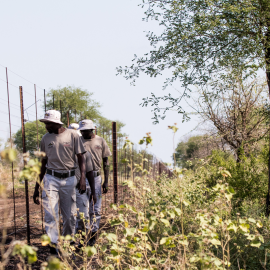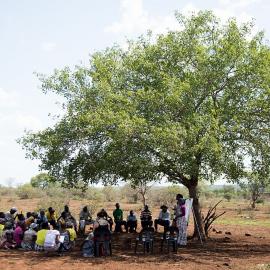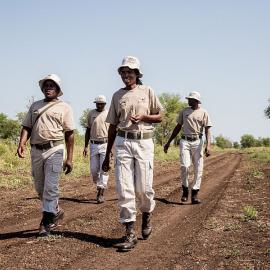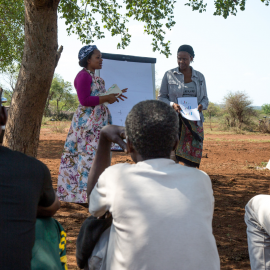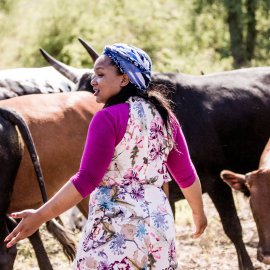Protecting wildlife by linking communities in Mozambique
Current initiative
Published
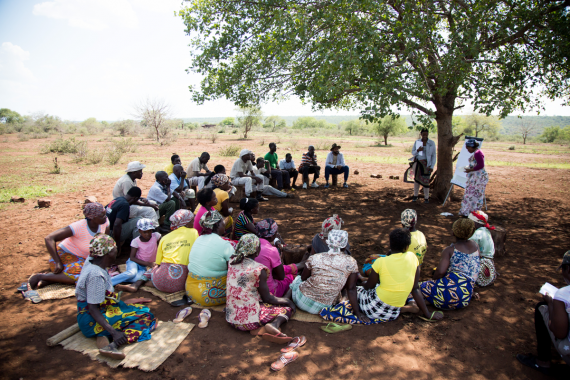
Credit: WWF-SA Nick Aldridge
WWF South Africa and partners have created a project with the Mangalane community of Mozambique to expand local economies and improve livelihoods as an alternative to engaging in illegal activities; improve accountable and democratic governance institutions for equitable benefit sharing; and raise awareness on the laws and regulations that empower the community to protect their natural resources. This initiative clearly shows that when people have positive attitudes toward wildlife and greater capacity to pursue sustainable livelihood opportunities and actually benefit from the wildlife they are trying to protect, wildlife populations can also benefit. However, positive attitudes alone are not enough - the various costs of living with wildlife must not exceed the range of benefits received.
Lead
Location
Located in the Moamba district in Mozambique, the Mangalane community is made up of five villages adjacent to Sabie Game Park (a 28 000 ha private hunting reserve that is part of a larger conservancy of private reserves in Mozambique), eastern border of South Africa's Kruger National Park.
The Mangalane community is made up of five villages on about 50 000 ha of land with a relatively small population - 27 households in Constine village (86 people), 148 households in Mavunguana village (620 people), 108 households in Mucacaza village (371 people), 104 households in Baptine village (557 people) and 42 households in Ndindiza village (189 people) - a total of 429 households with 1823 people. The community are subsistance farmers of maize and livestock, with some households being dependent on charcoal production in Mpoane woodlands. Community livelihoods are highly dependent on ecosystem services such as water from rivers and streams and wild vegetation to sustain their livelihoods.
The poaching and wildlife trade problem
Species affected African Elephant Loxodonta africana , Black Rhino Diceros bicornis , White Rhino Ceratotherium simum
Products in tradeRhino horn - medicinal, status, ornamental
Elephant tusks - Ivory, status, ornamental
Overview of the problem
Kruger National Park (KNP) is a target for poaching as it is home to the largest population of white rhino in the world and one of the largest populations of black rhinos.
As of 31st July 2014, 400 rhinos had been killed in KNP - a loss of nearly two per day. The total number of rhinos poached in KNP began to decline for the first time in 2016, from 826 in 2015 to 662 in 2016, to 504 in 2017 (DEA media reports). Despite the decline in poaching numbers, statistical modeling by South African Nationals Parks (SANParks) suggests that in all likelihood the birth rate is below the death rate and populations of both species have declined in the Park (AfRSG, 2016).
As the largest rhino area with the most numbers of rhino, Kruger is a critical site for ensuring the future of in-situ wild rhinos. According to SANParks, around 80% of all poaching incursions into KNP come from Mozambique, particularly by people moving across the eastern border of the park. Mozambique is known to act as an important entrepôt for horn sourced from South Africa for markets in Asia.
Although the focus is primarily on rhino horn, there is a great deal of concern around impacts of poaching of elephants for ivory in the park/area.
To some extent, Sabie Game Park (SGP), on the eastern boundary of KNP, acts as a buffer between people in Mozambique and the rhinos in KNP. The Mangalane community, which inhabits SGP, and other communities are to some extent involved in poaching. These communities are agriculture-based with very low incomes, few opportunities for alternative livelihoods and are disenfranchised with wildlife and conservation.
In addition, until the introduction of the new Conservation Areas law in April 2014, there has been very little legislation relating to illegal activities with wildlife in Mozambique, making wildlife crimes very difficult to police.
Their motivations to engage in illegal activity, such as poaching, are related to the following factors:
- Displacement of communities to establish SGP in 2009. The resettlement agreements have not been met fully by SGP and this has created resentment towards the reserve.
- Lack of proactive human-wildlife conflict mitigation strategies.
- Lack of employment opportunities, wage labour, basic infrastructure, and social services.
- Weak governance institutions without shared response to IWT enable criminal syndicates to instigate conflict, which facilitates IWT.
- Conflict with SGP law enforcement authorities who are accused of violating human rights while conducting random searches in the community.
- Intimidation by criminal syndicates.
"While some local people are poachers, most poaching groups come from outside of the Mangalane area and use the community as a primary transit point in and out of the SGP and Kruger. Many people from Mangalane thus work in support roles by providing information to poachers and/or working in the rhino-horn supply chain." (Massé et al. 2017).
"However, the Mangalane community is infiltrated by high levels of criminality that undermines local governance with added pressure on state law enforcement officials. The intimidation of community members leaves them without a choice but to participate in illegal activity" (Vundla, 2018).
Additionally, although other people from the Mangalane community may not be the actual poachers, some participate in the facilitation of poaching activities, such as providing accommodation, food, and water to poachers, to earn income.
The anti-IWT initiative
This initiative is focussed on tackling IWT. Specifically, the illegal cross-border trade of rhino horn in KNP in South Africa.
Community engagement is part of a wider set of strategies used. With funding from the Darwin Initiative (2015-2018), this project is addressing the threats to rhinos in KNP by developing alternative wildlife-based sources of income, enhancing community governance structures and increasing awareness of new legislation in the Mangalane community.
Beneficiaries of this project are members of five villages of the Mangalane community living in the buffer area adjacent to the Sabi Game Park.
The project's theory of change is based on an understanding that people are dependent upon natural resource use in much of Africa. The project aims to develop a model for wildlife-tourism that benefits communities and, as a result, reduces illegal activity. Within this overarching goal is the need to identify a range of opportunities for income generation, both from agriculture development as well as wildlife-based industry. The basic premise of the project is that greater involvement by the Mangalane community in natural resource management will lead to poverty reduction and improved livelihoods and, in turn, this will lay a foundation for reduced criminal activity.
In parallel, community governance was strengthened to ensure active participation and equitable benefits sharing within the Mangalane community, with a particular focus on equitable benefit distribution, and including the most vulnerable members, such as women. Formal committees and regular community meetings were used to build capacity within the community to monitor and manage income and information. The project also increased awareness about the new “Conservation Areas” law in both the community (through workshops) and government structures. In addition, a mechanism for apprehending and prosecuting poachers and other illegal activities associated with wildlife and natural resource management was agreed and implemented by the community, private landholders as well as the judiciary and police.
Strengthening governance of the whole community has meant that people now have the power to exercise their rights and contribute their ideas towards the future development of the community. Additionally, people have the capacity to participate in decision-making processes, including benefit sharing.
Our initiative targets all members from five villages of the Mangalane community as singling out poachers would have incurred a safety risk for the community.
The project did not assume that the poorest are most like to be involved in IWT. However, we learnt that the more elite members of the community who hold power are commonly involved in IWT as they use their authority to facilitate illegal activity.
The “rules of engagement” for working with communities includes:
- Build the capacity of local people to manage and benefit from wildlife
- Include local people in wildlife monitoring
- Ensure wildlife generate benefits, both tangible and intangible, for local people
- Ensure benefits are shared equitably
Although local community members were not involved in the design of the initiative per se, the first phase of the project was designed by WWF SA and partners following a baseline survey that was conducted in 2013 to understand community attituted towards wildlife, community governance and livelihoods. This provided a framework for engaging with the community.
However, implementation of the initiative was driven by the community, thus following a more bottom-up approach to ensure that outcomes are community driven.
The second phase of the project aims to co-design the project with the community with a vision of the community eventually owning the project. The second phase is called Khetha "choice" and is being implemented with support from its development partner, the United States Agency for International Development (USAID). The Khetha Program in the Great Limpopo Transfrontier Conservation Area (GLTFCA) is building partnerships between the governments of South Africa and Mozambique, community leadership, and NGOs to address wildlife trafficking. These partnerships include communities in the formulation of strategies, plans and initiatives that aim to address the underlying causes that lead to IWT and improve the benefits the community receives from protected areas and wildlife.
The strategy
Strengthening disincentives for illegal behaviour
21 Community-elected youth from five villages of the Mangalane community participated in the community scouts programme. The programme was established as a proactive response to the need to mitigate human-wildlife conflict by reporting any stray animals. Their responsibilities as defined by the community including cattle theft monitoring, fire management, and human welfare. The village scouts use the Management Oriented Monitoring System (MOMS) paper-based form to collect data and report incidences back to the community on a monthly basis. The village scouts are employed through Sabie Game Park with funding support from WWF SA.
Our partners at WWF Mozambique were responsible for training government officials and community members about the New Conservation Area Laws. The understanding of the requirements for implementation resulted in the commitment to implement the CITES Resolutions, International Consortium on Combating Wildlife Crime (ICCWC) toolkit and to increase prosecutions with effective implementation of the newly approved revised Conservation Area Law.
According to Vundla (2018) efforts to reduce IWT have been done through contemporary law enforcement systems and neglected traditional knowledge systems. The Mangalane community argues that their opinions have been neglected by law enforcement officials regarding the correction of offenders. The community suggested that contemporary systems are focused on naming-and-shaming and not reformation hence promoting isolation of offenders and subsequent gangsterism to overthrow community governance.
Increasing incentives for wildlife stewardship
Mozambiquan Conservation Area Laws allow communities living adjacent to game reserves to benefit from at least 20% revenue from the wildlife economy. Our project was instrumental in unlocking this income to the community through governance institutions, and has been paid annually as household cash and paid into a community project account. Some of the money is generated from trophy hunting to contribute to the development of the community.
The Mangalane community receives an annual hunting quota for subsistence use. This was done through the understanding of the extent of poverty and household food insecurity worsened by periodic droughts that undermine subsistence farming.
About 12 members of the Mangalane community participated in a eight day field trip to South Africa to learn about the economic opportunities of the wildlife economy such as hospitality, camping, hiking, restaurants, environmental education among others. The selected delegates provided a print out of images of their field trip to report back to the community to begin thinking about their long-term vision for their community.
Decreasing the costs of living with wildlife
Lion proof cattle enclosure (kraals) were constructed in the community to reduce impacts at night. The enclosures targeted households living close to the reserve fence who often reported the loss of cattle due to lion predation.
The village scouts programme is a human-wildlife conflict mitigation strategy consisting of 21 community-elected youth. Their responsibilities include monitoring wildlife that has escaped from the park, supporting community safety as poachers attract crime and lawlessness in the community such as cattle theft, alcoholism, and human trafficking. Sabie Game Park in partnership with village scouts effectively and efficiently attends to straying wildlife, such as elephants and buffalos, as soon as wildlife has been spotted outside the reserve fence and herd them back to the game reserve.
Increasing livelihoods that are not related to wildlife
Small grants programme for small business enterprises in the community that include: goat rearing, Paõ bread bakery, food gardens, and steelworks. → positively impacted 50 households of which 60% are headed by women.
Due to the prolonged drought in 2015, we established the Food for Conservation Programme where the community participated in conservation-related activities in exchange for food. The food parcels were received in three cycles and received by all households of the Mangalane community. Vundla (2018) added that the community is interested in participating in activities that restore the dignity to the people such as employment and earning a living rather than being passive recipients of food aid. Sabie Game Park also allows access to water inside the reserve for cattle to drink and extend their veterinary service to community livestock.
Improving education and awareness
Further detailIn partnership with WWF Mozambique, awareness raising training about the New Conservation Area Laws and IWT was given to the Mangalane community. The training covered the topics of poaching, tourism, wildlife economy, and community safety.
WWF Mozambique facilitated field visits and training with the Attorney General’s Office to educate representatives of the judiciary about the negative chain of wildlife crime, the benefits of tourism for communities and economic investment in the country. These engagements led to the acceptance of the revised Conservation Area Laws by Parliament amending sentencing from 12 to 16 years imprisonment for wildlife-related crime.
Has the initiative made a difference?
Poaching in the study area is decreasing.
The total number of rhinos poached in KNP began to decline for the first time in 2016, from 826 in 2015 to 662 in 2016, to 504 in 2017 (DEA media reports). Despite the decline in poaching numbers, statistical modeling by SANParks suggests that in all likelihood the birth rate is below the death rate and populations of both species have declined in the Park (AfRSG, 2016).
The number of rhinos illegally killed on Sabie Game Park declined from 15 animals during the first year of the project (April 2015 - March 2016) to six animals during the second year of the project (April 2016 - March 2017) and zero between May 2017 and March 2018.
Furthermore, anecdotal evidence from SANParks suggests that the positive impacts of activities on and around SGP have reduced the threat of poaching in the geographical area in KNP adjacent to the SGP boundary.
In addition to reducing poaching, the initiative has been successful in the following ways:
Attitudes toward wildlife. A positive attitude of 80% towards wildlife can be observed in the dashboard survey in 2018, the same as for 2017. This is a 60% increase from 20% in 2016. Our project has exceeded the 70% target by 10% of positive attitudes towards wildlife.
Behavioral. The 2018 dashboard survey shows that the social acceptability of poachers in the community has declined to 24% among adults compared to 82% in 2017, 62% in 2016 and 48% in 2015. The change is through the recognition that poachers are involved in other crimes in the community such as cattle theft, human trafficking, intimidation, and lawlessness. We have made good progress towards our 10% target of acceptability.
Policy change. WWF Mozambique facilitated field visits and training with the Attorney General’s Office to educate representatives of the judiciary about the negative chain of wildlife crime, the benefits of tourism for communities and economic investment in the country. These engagements led to the acceptance of the revised Conservation Area Laws by Parliament amending sentencing from 12 years to 16 years imprisonment for wildlife-related crime, including people who finance poaching or receive illegal wildlife products.
Despite this, the project is considered to have been only partially effective. What we haven't achieved is higher participation in an expanded wildlife-driven economy that contributes to sustainable livelihoods and multi-dimensional poverty reduction. However, with more participation and improved attitudes toward wildlife, the Mangalane community now has a social foundation to combat IWT.
Poaching has been largely assumed to be facilitated by poverty, but we have learned that vulnerability as a result of inadequate social security has far greater implications on poaching and must also be addressed.
Key Lessons include:
- IWT does not only affect game reserves and wildlife, but it also impacts local communities. Communities need effective law enforcement as they continue to be victims of intimidation, lawlessness, human trafficking, and more - linked to criminal syndicates. We have learned that safer communities also improves security for wildlife.
- Conservation laws are important for managing wildlife populations. However, more work is required in understanding the impacts of conservation policies and regulations on local communities who are dependent on the natural environment to survive.
- As we continue to seek positive growth rates of wildlife within national parks, equal attention is needed to address human-wildlife conflict and to improve community attitudes towards wildlife. As wildlife numbers thrive, livelihoods of adjacent communities must not be compromised, and preventative measures are better than reactive responses.
- Conservation projects around the world have made positive contributions to community development and wildlife protection. However, little attention has been given to empowering communities to participate in national and international forums to discuss wildlife issues that directly impact on their livelihoods. This includes project planning processes, policy reviews, conferences, among others.
- Project progress can be hindered by external criminal syndicates that benefit from poaching and IWT: there will be retaliation and attempts to disrupt field operations and intimidation of community members to prevent them from supporting the project. We have learned that an organised and transparent community makes it harder for criminal syndicates to perform illegal activities as communities actively condemn their activities.
What works and why
By supporting community livelihoods, we learned that people want to develop a local economy based on their own skills and needs. Supporting livelihoods also means that the community is given the power to develop a more sustainable future.
Additionally, targeting women in livelihood development is the most powerful way to drive livelihood change as they are very influential members of the community.
By involving the community in natural resource management, we enable people to improve their relationship with the environment while considering their development needs.
Factors for success
Supportive national policy/legislation for devolved governance of natural resources
Supportive national policy/legislation on sustainable use of natural resources
Long-term donor support that is flexible, adaptive and/or based on realistic time goals
Supportive, multi-stakeholder partnerships with a shared vision
Devolved decision-making power so local communities have a voice in creating or co-creating solutions (as part of the initiative)
The Mozambique Conservation Area Laws allow the communities living with wildlife to benefit from 20% of revenue generated by the wildlife economy. However, 20% is too small to improve livelihoods; increasing this income will meaningfully contribute to community development.
The Mozambique Conservation Area Laws allow local communities to develop land-use plans, obtain title deeds and acquire permits to utilise natural resources known as DUATS. However, there are concerns that there is insufficient capacity within government to facilitate land-use mapping and planning.
United States Agency for International Development (USAID): Khetha Progam
Good partnerships have provided a highly functional and learning environment for our project. Each partner, including the Mangalane community, has clearly defined responsibilities within the project.
Sabie Game Park (SGP) and the Mangalane community work together to implement the project on the ground following the ‘learning-by-doing’ approach. SGP and SAWC also provided training to community scouts in wildlife monitoring and protection. In addition, WWF Mozambique plays an important role in adding linkages to National government structures. Additionally, SGP, WWF Mozambique and provincial government structures played key roles in ensuring 20% of wildlife revenue is received by the community.
Prof. Brian Child provides high-level technical oversight and acts as part of the Steering Committee. The project management support teams represented by individuals from each organisation participate in monthly technical and steering committee project teleconferences for monitoring and evaluation purposes to ensure that project activities are on schedule and make decisions around adaptive management as necessary. The project partnership is built on the identification of partner strengths within the South Africa-Mozambique landscape.
Administracao Nacional de Areas de Conservacao (ANAC) - who are the national conservation area management authorities in Mozambique - have been key partners, enabling the effective implementation of the New Conservation Area Laws and unlocking the financial benefits of wildlife to the Mangalane community. ANAC has also partnered with our project through WWF Mozambique to facilitate training of law enforcement officials in the country.
Chef de Post, the Moamba, Local District Administrator, ensures correct management of all administrative processes regarding funds in community accounts, as well as reporting activities at community level. Chef de Post also assists in managing traditional authority conflicts which may negatively impact on our project.
The baseline survey conducted in 2015 showed weak governance institutions in the community. Weaknesses include broken communication and information sharing, unequal benefit sharing, dictatorship, exclusion from decision-making processes, among others.
Our project provided support to the existing institution by establishing committees in each village. The committee is accountable to the community and has the responsibility of ensuring the involvement of the community in decision-making processes, registration of households for equitable benefit sharing, and ensuring all members of the community have access to information. The community also has the power to remove underperforming leaders.
Committee membership is established by democratic elections in the villages. The committees are accountable to the community with regards to project planning and financial management. Underperforming leaders are removed by means of community developed constitution. Some of the leaders have been involved in financial misconduct and has contributed to strengthening the community constitution.
What doesn’t work and why
Addressing socio-economic drivers of IWT is very complex and requires a deep understanding of the society in question as well as an excellent understanding of social science.
With regard to improving local economic opportunities through agriculture, the limited access to water sources (rivers, boreholes, piped water etc.) means that huge resources would be required to establish a sustainable initiative. With prolonged drought periods and low food production, household food insecurity worsened and poaching became inevitable. As such, the Food for Conservation Programme was introduced as a temporary alternative of three cycles, which redirected funds from the initial plan as an adaptation and mitigation strategy. Climate change risk and planning was not part of our project design.
We had also planned to improve tourism activity within SGP to increase employment of people in the community. However, the unstable economic environment within the country did not provide an enabling environment for investment. Additionally, we learned that most people in the community had never been exposed to employment and didn't have basic employment skills. As such, more funding is required to train potential employees to equip them with these.
Regarding governance, our project was designed with an understanding and intention to support and improve the traditional governance institution. One of our key activities was to help the community develop a constitution to ensure equitable benefit distribution. Due to low literacy levels, the constitution was rejected as people are unable to read it or trust the document. This resulted in some leaders misusing funds without accountability to the community. The constitution was then proposed to be done in a form of an infographic.
Involving the community was a key component of our work through the community scouts programme. However, once people were trained and capacity was built, people left the scouts programme to pursue other employment opportunities in different sectors. While employment is applauded, the project lost potential leaders and skilled persons to lead the initiative in the long-term. The project did not have a skills retention plan for the village scouts programme which needs to be considered in future.
Factors that limited or hindered success
Lack of coordinated and coherent sectoral policies/legislation (For example, land use planning, agricultural etc...)
Lack of clearly defined tenure or resource use rights
At this stage, the community does not have the rights to utilise the natural resources. The community needs secure land tenure to protect their natural assets and household.
Community safety and security: The level of criminality in the community continues to undermine positive contributions towards economic development. Coupled with 'under capacitated' law enforcement officials, criminal syndicates threaten people, community assets such as cattle and facilitate IWT.
Influence of syndicates in the community: "In describing his anti-poaching duties, one scout explained how fellow community members accuse scouts of disrupting their livelihoods by making it more difficult to hunt (rhino), and that they are responsible for community members, being arrested and put in jail." (Massé et al. 2017).
- Those associated with poaching are seen as enriching the community, at least in monetary terms, while anti-poaching forces (scouts or otherwise) are seen as impeding that source of wealth and income.
- Focus groups with scouts revealed how their patrol duties take them away from farming, which is needed to feed their families in the absence of higher wages. Indeed, scouts, rangers and environmental police all claimed to be denigrated by community members involved in poaching, and being insulted for being ‘poor’, having ‘no future’ and being ‘unable to properly support their families’, because they do not involve themselves in poaching (Massé et al. 2017).
"Such perceptions (and the reality) of scouts and rangers make it difficult to convince young men to view them as role models, compared to those in the poaching economy who reflect the lifestyle and wealth to which they aspire".
- Scouts unanimously spoke of the alienation they faced after being labeled ‘traitors’ or accused of ‘working with the white men’, since anti-poaching is seen to benefit white-run private reserves or South Africa, and not local communities.
- Intra-community tensions, if not outright violence against scouts.
Corruption: Corruption in wildlife trafficking can be observed at various levels, community, game reserve rangers, and even government officials. While good efforts are being made to reduce the impacts on species, the legal benefit cannot compete with illegal gains.
Economic development: The high levels of poverty and limited economic development opportunities in the community is a contributing factor for involvement in IWT. Food insecurity is worsened by droughts negatively impacting subsistence farming potential of the community.
Additionally, limited government support in social development is hindering the progress of the project.
Organisers, donors and partners
Partners: WWF South Africa, Southern African Wildlife College (SAWC), Sabie Game Park (SGP) and the Mangalane community.
Sabie Game Park (SGP) and the Mangalane community work together to implement the project on the ground following the ‘learning-by-doing’ approach. SGP and SAWC also provided training to community scouts in wildlife monitoring and protection. In addition, WWF Mozambique plays an important role in adding linkages to National government structures. Additionally, SGP, WWF Mozambique and provincial government structures played key roles in ensuring 20% of wildlife revenue is received at the community to address household livelihood needs.
Government support: Administracao Nacional de Areas de Conservacao (ANAC) who are the national conservation area management authorities in Mozambique have been key partners to enable the effective implementation of the New Conservation Area Laws and unlocking financial benefits of wildlife to the Mangalane community. ANAC has also partnered with our project through WWF Mozambique to facilitate training of law enforcement officials in the country.
Donors: UK Department for Environment Food and Rural Affairs through the Illegal Wildlife Trade Challenge Fund.
For further information contact Nelisiwe Vundla (nvundla@wwf.org.za).

